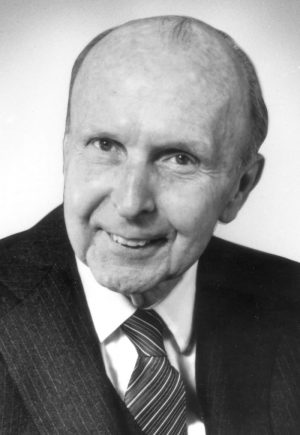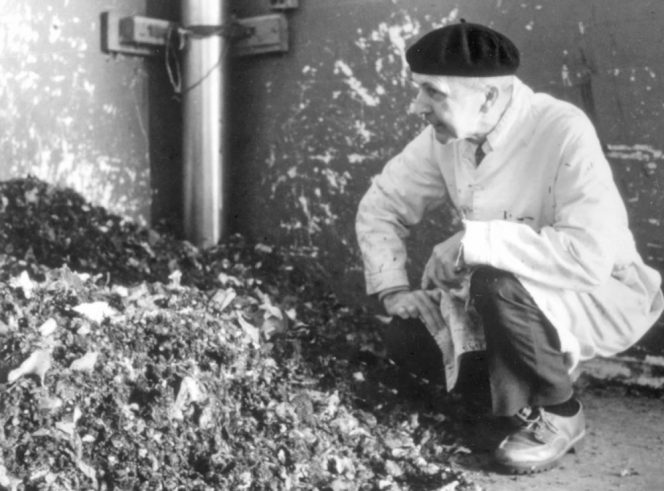BioCycle looks back to the writings of Dr. Clarence Golueke to review the science and fundamentals of composting.
Nora Goldstein
BioCycle October 2018

Dr. Clarence Golueke, internationally recognized researcher and communicator on the science of composting.
In the Introduction to The BioCycle Guide to The Art & Science of Composting, published by The JG Press, Inc. in 1991, Jerome (Jerry) Goldstein, Editor and Publisher, wrote that “success in composting requires the right attitude as well as the right technology.” This truly is the essence of composting; it is an art and a science. Jerry spoke to the “great transformation” that he had seen take place in the 30 years since he founded BioCycle as Compost Science in 1960: “The once dimly viewed alternative is now a mainstream method …. The concept has become a reality, and the need for effective implementation through the right management techniques has never been more critical.”
He also noted that since 1960, “the presence of Dr. Clarence Golueke has been the steadiest, and we believe, the most consistently positive force on the compost scene.” Golueke, who died in 2004, was internationally recognized for his research contributions to the science of composting and his work in the entire spectrum of solid waste management. He had an enormous role in the launch and development of Compost Science and also served as the initial editor of the journal, Compost Science & Utilization, when it was founded by The JG Press, Inc. (publisher of BioCycle) in 1992.
When I joined BioCycle in 1978, having just graduated with a degree in history, I turned to Dr. Golueke for my composting education. He started with, and kept coming back to, the Biology, Principles and Limiting Factors that underlie success when practicing the art and science of composting. As we approach our 60th Anniversary in 2019, it is important to go back to the basics, the science of composting. Revisiting those fundamentals provides a valuable refresher and sharpens our ability to evaluate the “latest and greatest” systems and marketing claims.
The following, written by Dr. Golueke, is excerpted from The BioCycle Guide to The Art & Science of Composting.
Basic Principles
Whatever feedstock a compost project involves, there are basic principles upon which success or failure depends. The first and most basic principle is to the effect that composting is a biological process. As a biological process, composting has all the advantages and limitations of a biological process. Chief among the limitations is the fact that the potential capacity and performance of all compost systems are determined by those of their microbiological components.
The greatest exaggerations are in the form of claims that exceed the potential of biological reactions. In this regard, the major abuse is with respect to speed of the process, e.g., claims may be made that required residence times are as brief as two or three days. However, the claims are becoming more realistic, albeit verging on overly optimistic. Fortunately, shortcomings resulting from exaggerations regarding duration of the “active” (high-temperature) phase of the process generally are compensated by much more modest claims regarding the curing or maturation phase.
To avoid unwarranted expectations and subsequent disappointments, a prudent course to pursue not only with respect to claims but even more so with respect to design and construction and the establishment of goals, is to err on the side of conservatism. It is true that the process can be considerably accelerated with very well defined limits through the provision of elaborate measures for maintaining all nutritional and environmental factors at optimum levels for the microbial populations most active in the process. On the other hand, it is equally true that such a course materially increases the cost of a process, the economic feasibility of which is particularly sensitive to costs. In other words, economic feasibility is a serious controlling factor.
The all too commonly overlooked principle of the limiting factor sets upper and lower limits on all nutritional and environmental factors. The limiting factor may be defined as the one that is in lowest supply or is exhausted most rapidly. It thus becomes the factor that limits the growth and activities of the organisms under consideration — in this case, the organisms active in the composting process.
A corollary of the limiting factor is that unless each and every factor is adequately met, problems will arise. Therefore, problem prevention becomes a matter of designing and operating a system such that no operational, nutritional, environmental, or other conceivable factor be deficient, i.e., becomes limiting. Yet another facet of the limiting factor principle is its positive relation to sound economics.
Carbon/Nitrogen Basics
Carbon
Carbon is used by microbes as a source of energy through metabolic oxidation and as the most important, i.e., abundant component in the synthesis of the cell wall and other cellular structures, and of the protoplasm. It is the oxidation of carbon to carbon dioxide that accounts for the greatest part of the loss of mass and generation of heat that are so characteristic of composting.
An important point that often is overlooked regarding the carbon in the substrate is the ability of the desired microbes to utilize it, i.e., its “availability” to the bacteria. The usual requirement for ability is the presence of enzymatic systems capable of breaking up target molecules and thereby rendering their carbon accessible to microbial utilization. The systems either may originate in the active microbes or may be supplied by other microbes. This requirement is true not only with carbon but also with all other essential nutrients. Some molecules are more resistant to microbial attack than others.

“As a biological process, composting has all the advantages and limitations of a biological process,” quipped Dr. Golueke.
Therefore, substances made up of such molecules (complex celluloses, lignin) are broken down more slowly than are others (sugars, proteins, most fats). The import of this fact is that certain resistant compounds (substrates) are broken down slowly despite sophistication of reactor design and construction and the imposition of optimal levels of nutritional and operational factors. In short, microbial ability to break down the compounds is ultimately the decisive factor.
A practical aspect of carbon availability is that it determines:
•Suitability of a waste as a carbon source
•Rate at which the waste can be broken down (i.e. residence time)
•Permissible upper level of C:N ratios
An example of a practical consequence is the use, repeated recovery, and reuse of a woody residue (sawdust, wood shavings) as a bulking agent in the composting of sewage sludge. Although it is true that some groups of fungi are particularly destructive with respect to wood products (including woody wastes), it is difficult to safely and effectively incorporate them into a routine waste treatment process.
For the most part, the carbon in the garbage fraction (food wastes and food preparation wastes) and in yard and garden debris (including green or “dry” leaves, twigs, chipped small “green” branches) is readily available, and hence easily broken down. A large part of the carbon in the refuse fraction of MSW is difficultly available because it is in the paper and paper products components of the waste. Of these components, newspaper stock is the most resistant. Regarding manures that contain bedding materials, the carbon in most bedding materials is difficultly available, although not to the same extent as in paper.
Nitrogen
Of the microbial macronutrients, nitrogen ranks with carbon in importance. Nitrogen is a major constituent of protoplasm. No microbial growth (multiplication, proliferation) takes place without nitrogen. On the other hand, microbial activity such as the synthesis of organic acids is possible in the absence of nitrogen.
The nitrogen in the garbage fraction of MSW, in yard and garden debris, in sewage sludge, and in animal manures (excepting bedding material) is readily available. Incidentally, these wastes are good sources of nitrogen for use in lowering C:N ratios.
C:N Ratio
The carbon to nitrogen ratio (C:N) is an important nutritional factor. Generally, the optimum ratio is within the range of 19 to 30 parts available carbon to 1 part available nitrogen. Raising the C:N to levels about 30:1 brings about a corresponding slowing of microbial activity. During the active phase, this slowing is manifested by a drop in heat production, in that the temperature of the mass either does not rise or it drops.
In addition, the rate of composting is slowed. At C:N ratios lower than 18 or 19:1, excess nitrogen is lost to the atmosphere in the form of ammonia, and the pH level may rise to inhibitory levels. An excess of ammonium ion may be toxic to microbes.
Low C:N ratios may be raised through the addition of carbonaceous wastes such as dry crop residues (“dry” leaves, fresh hay). High C:N ratios may be effectively lowered by adding grass clippings or poultry manures. Grass clippings are readily composted, provided they are prevented from matting and are kept suitably “fluffed.” An excellent preventive measure is to mix the clippings with leaves, plant stalks, etc.
Other Nutrients
Intermediate between macro and micronutrients are nutrient elements such as phosphorus, potassium, and calcium. Usually these elements are present in satisfactory, or at least, adequate concentrations in most MSW and its constituent fractions (garbage, yard, and garden debris). However, because of a quirk in human metabolism, etc., potassium generally is quite low in concentration in sewage sludge. Nevertheless, it is rarely a limiting factor. Calcium serves as a buffer in the compost process. It, too, usually is present in adequate supply. Wastes deficient in micronutrients are rarely encountered.
Environmental Factors
The next installment of this series focuses on three key environmental factors that affect composting: moisture content, aeration (molecular oxygen supply), and temperature. Wrote Dr. Golueke in The BioCycle Guide to The Art & Science of Composting, “in addition to technology and marketing the compost product, these three factors have been and are attracting the major share of the attention directed to composting. Moreover, the treatment accorded these factors illustrates the dangers mentioned in the preceding paragraphs [above].”










